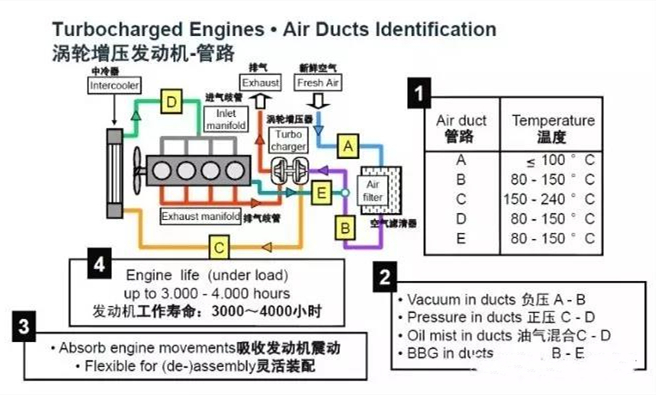
Performance requirements for rubber hoses for turbocharging systems
Turbocharging is a technology that utilizes the exhaust gas generated by the operation of an internal combustion engine to drive an air compressor. The main function of car turbocharging is to increase the engine's intake air volume, thereby increasing the engine's power and torque, making the car more powerful. But after turbocharging, the pressure and temperature of the engine greatly increase during operation, so while using turbocharging technology on the engine, material progress is also crucial.

High temperature resistance
The turbocharged gas undergoes compression and intense friction, resulting in high temperatures. Even after cooling, the temperature of the gas usually reaches over 100 ℃. Therefore, the rubber hose materials used in turbocharging systems must be able to withstand high temperatures, and ordinary natural rubber, styrene butadiene rubber, and cis-1,4-polybutadiene rubber cannot meet the requirements for use under high temperature conditions. Therefore, special rubber materials with high temperature resistance must be used. As the pressure of turbocharging increases, the temperature of the gas passing through the pipeline also increases. If the pressure reaches 3.5 × At 105Pa, the temperature of the gas passing through the pipeline can reach over 250 ℃, and there are very few types of rubber that can be used in such high temperature environments.
Oil resistance
The gas passing through the turbocharger system hose is generally mixed with oil and gas, so the hose must have certain oil resistance, especially high-temperature oil and gas resistance. Some rubbers with good high-temperature resistance (such as silicone rubber) have poor oil resistance, so it is necessary to add an inner lining layer on the inner wall of the silicone rubber pipe to prevent oil and gas erosion.
Strength
The turbocharging system not only has high temperature, but also has a certain amount of pressure, especially the pressure borne by the high-temperature pipeline is relatively high. Although turbocharged rubber pipes generally use reinforced rubber pipes (the main pressure bearing part is the reinforced layer), it is also required that the rubber has a certain strength to improve the overall strength of the rubber pipes; In addition, in order to meet the needs of production processes and assembly, rubber is also required to have high tensile and tear strength.
Compression permanent deformation
In general, the turbocharger hose is connected to the metal pipe through a clamp to form a pipeline. At high temperatures, rubber should have good resistance to deformation, otherwise excessive compression permanent deformation can cause the clamp to loosen and the rubber tube to fall off, leading to quality accidents.
Cold resistance
Although the rubber hoses are used in high-temperature environments after the engine is started, they are exposed to cold air after parking. When the engine starts at low temperatures in cold regions in winter, the rubber tube vibrates at low temperatures. If the low temperature resistance of the rubber is poor, the rubber tube will become hard and brittle, leading to tearing, detachment, loss of damping function, and other problems.
Adhesion strength
The rubber layer of the rubber hose should maintain good adhesion with the reinforcement layer and inner lining layer in harsh environments such as cold, hot, oil and gas, and have a certain adhesion strength to ensure that there is no delamination phenomenon. The adhesion strength is closely related to the characteristics and formula of the rubber itself, as well as the impregnation pretreatment method of the reinforcement layer, the selection of adhesives, and the bonding process. It should be comprehensively considered.
Hardness
Rubber should have appropriate hardness. The hardness is too high, and the stiffness of the rubber hose is too large to play a damping role, and assembly is difficult and easy to fall off; The hardness is too low, and the strength is difficult to guarantee.

 WeChat official account
WeChat official account
